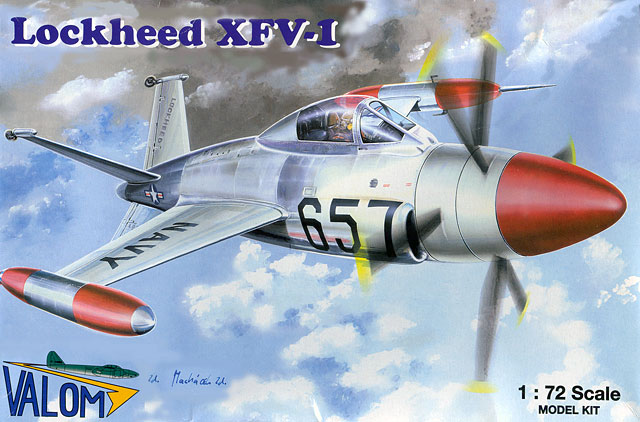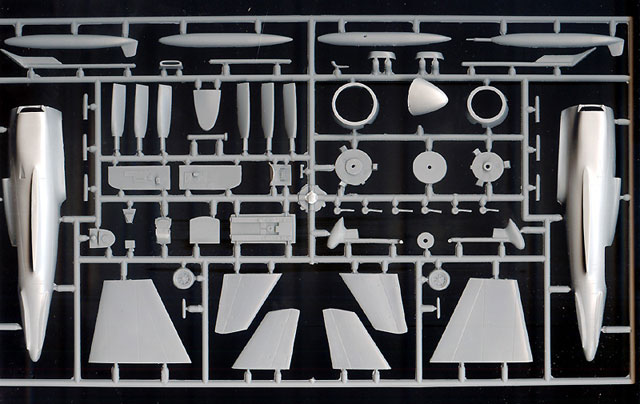|
Lockheed XFV-1 Salmon

Valom 1/72
S
u m m a r y
|
| Catalogue Number: |
720007 - Lockheed XFV-1 |
| Scale: |
1/72 |
| Contents and Media: |
62 parts in light grey plastic on
two sprues, one photo-etched fret, printed
instruments on clear acetate; 2
vac-formed canopies, Decals for one aircraft and 2 double sided A4
sheets with history, parts plan, build instructions and colour and
marking drawings. |
| Price: |
USD$32.96 from Squadron.com
|
| Review Type: |
FirstLook |
| Advantages: |
Fascinating subject, well moulded
plastic parts;
nicely detailed. |
| Disadvantages: |
Limited run nature will require
experience and care |
| Recommendation: |
Recommended |
Reviewed by Rodger Kelly

Valom's 1/72 scale
Lockheed XFV-1
is available online from Squadron.com
Valom Aircraft Models is another new producer from the Czech Republic
who specializes in producing limited-run mixed media kits of aircraft
that are not likely to be produced by the mainstream kit manufacturers.
Valom's latest offering is a 1/72 scale rendering of the Lockheed XFV-1
Salmon. What was a XFV-1 and why was it produced? Basically,
the XFV-1 was an experimental vertical takeoff aircraft of the 1950s.
It was produced as a result of a proposal issued by the United States
Navy in 1948 for an aircraft that was capable of vertical take off and
landing from platforms mounted on the afterdecks of conventional ships.
In 1950 this requirement was revised to call for a research aircraft
capable of eventually evolving into a vertical take off and landing
ship-based convoy escort fighter. Two prototypes were ordered from
Lockheed under the designation XFO-1. Lockheed's company designation was
Model 081-40-01. Aircraft serials were Bureau Number 138657 (the
subject of this kit) and 138658.
The
kit comprises 62 plastic pieces produced using the "limited run"
process, a photo-etch brass sheet that carries an instrument panel and
smaller detail parts for the cockpit including the seat harness, a
printed acetate sheet (instrument panel) and two vacform canopies.

Click the thumbnails below to view larger images:
Given that the kit has been produced using the "limited run" process,
the parts are commendably thin and carry a fair amount of detail.
Whilst the outer surfaces of the parts are reasonably smooth, they will
not be smooth enough for the natural metal finish that the
one-to-one-scale version wore so you will need to spend some time with
the sandpaper here. A saving grace here is that the plastic that Valom
have used works easily.
Surface detail is of the scribed line variety, and this too will need
some attention with your favourite scriber to even them all out as
straight out of the box, they are a little inconsistent in depth and run
a little "outside the lines" in some areas. There is some flash
present, but not a great deal and what there is will easily be removed
with sandpaper and a sharp knife.
As
mentioned previously, the canopy is vacformed. Whilst they are clear
and without distortion, frame detail is a little soft and it would help
if you were to outline them in tape before attempting to remove them
from the carrier. I say them, as whilst you only need one, two are
provided in case you goof. To make the removal task easier, I have
always found that it helps to fill the canopy with plaster of paris
first as once this has hardened, you have something hard to cut
against.
The
instrument panel is of the sandwich type with the instrument dials being
provided on the printed acetate sheet which you place between the
plastic and brass instrument panels – simple but very effective.
The
instructions are a large folded single-page that show "exploded views"
and provide simple yet effective guidance in the construction and detail
painting of your model as well as a "parts map" and a thumbnail history
of the XFV-1.
Decals have been printed by Aviprint who seem to print the majority of
decals for these Czech based companies. What there is of them are sharp
clear and in register and they appear to be correct when compared to
photographs of the one-to-one-scale 138657.
The
main sprue – there is only one – is packed in a plastic bag and the
decals, photo-etch fret and acetate instruments are packed in a smaller
zip-loc bag that also contains a piece of stiff cardboard to help keep
them all flat. These are in turn placed into a cardboard tray type box
with a reinforced bottom. Our fearless editor mailed this kit to me in
a plastic overnight bag and it made its way from one side of our vast
continent to the other with minimal crushing to the box and only the
nose cone separating from the sprue (sorry Rodger - I'll use more
bubblewrap next time! - ed). One of bulkheads was also a little
bent but was easily repaired using hot water.
This is a nice kit but
make no mistake, it is not for the inexperienced nor the feint of heart
as it is by nature a limited run kit that is devoid of alignment pins.
Being in natural metal finish too will mean you will have to spend a lot
of time on careful construction.
Recommended to
experienced modellers.
Footnote
If you want to see
what the finished model looks like, head on over to Modelling Madness at
http://modelingmadness.com/scotts/korean/us/xfv1.htm where Scott Van
Aken provides a blow by blow description of the construction of this kit
and some great photos.
Thanks to Valom for this review
sample.
Review and Images Copyright © 2005 by Rodger Kelly
Page Created 13 June, 2005
Last updated 13 June, 2005
Back to HyperScale Main Page
Back to Reviews Page
|
Home | What's
New | Features
| Gallery |
Reviews | Reference
| Forum
| Search